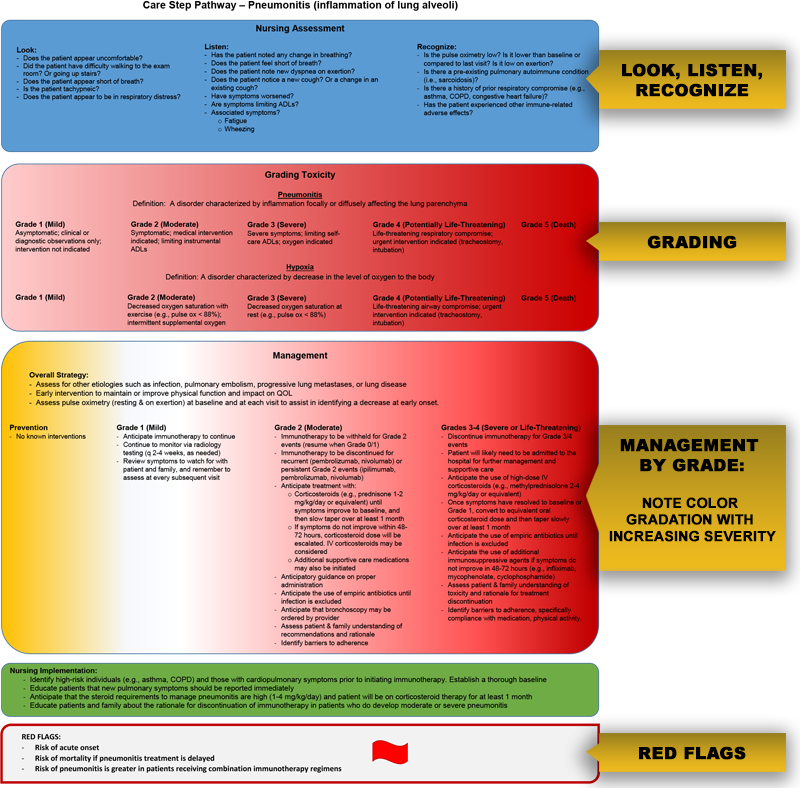Welcome to the Care Step Pathways
This section provides stand-alone CSPs for viewing and downloading. The CSP is an innovative and practical tool developed by the members of the MNI to address notable toxicities unique to targeted therapy or immunotherapies. The CSPs include specialized formats and components designed to provide comprehensive nursing assessment and management strategies in a visually appealing and easy-to-use format. Each outlines essential components of the nursing functions specific to that adverse effect. The CSPs are inclusive—you will find the CSPs for the BRAF/MEK inhibitors have specific information for both FDA-approved BRAF/MEK inhibitor combinations as is the case for the immunotherapy CSPs (they contain specific information for FDA-approved checkpoint inhibitor monotherapy and combination therapy regimens). Intralesional therapy has its own CSP.
As shown in the figure, the “Look, Listen, and Recognize” section guides oncology nurses to a specific set of symptom-related questions to ask the patient and/or caregiver as well as additional information to consider/review as part of the nursing assessment. The information obtained from this focused assessment will direct the appropriate management and nursing-specific interventions. Next is the grading section. Wherever possible, we used the Common Terminology (or Toxicity) Criteria for Adverse Events (CTCAE) for grading, which allows for interpretation of subjective symptoms in an objective manner. These criteria employ a grading system—from 1 (mild) to 5 (death)—to represent that toxicity defined by specific parameters according to the organ system involved. In some cases, these CTCAE criteria are in evolution, particularly for the assessment of immune-mediated endocrinopathies, for which detail is lacking in the current criteria. For this reason, our faculty relied on more practical, clinically oriented grading systems for adverse events such as thyroiditis and type 1 diabetes.
Finally, as shown in the figure, the CSPs address management. Here, our focus is both on the practical, nurse-led interventions that oncology nurses can and should undertake as well as anticipatory guidance regarding drug holds/discontinuations, dosage adjustments, and management strategies. The color scheme used in the management sections (light pink to dark red with increasing severity) helps reemphasize the treatment-by-grade approach. Moreover, red flags serve as a reminder to intervene rapidly at the recognition of signs/symptoms of more serious, life-threatening manifestations of these AEs.
Below are the CSPs, each of which is available in 2 formats—a vertically oriented PDF for viewing as well as a printable PDF. The printable PDF is oriented to print in landscape mode.
We hope that you find these CSPs useful in your efforts to optimize care for your patients with melanoma.
List of CSPs
For BRAF/MEK inhibitors Targeted Therapies:
Cotellic/Zelboraf
Tafinlar/Mekinist
Braftovi/Mektovi
- Skin Toxicity – View Online | Download For Print (Landscape)
- Pyrexia** – View Online | Download For Print (Landscape)
- Cardiotoxicity – View Online | Download For Print (Landscape)
- Ocular Toxicities – View Online | Download For Print (Landscape)
- Adherence – View Online | Download For Print (Landscape)
**NOTE: Does not provide recommendations for Braftovi/Mektovi
For Intralesional Therapy:
Imlygic
- Overall Side Effects – View Online | Download For Print (Landscape)
For Bispecific T-cell Engager Therapy:
KIMMTRAK® (Tebentafusp-tebn)
- Cytokine Release Syndrome – View Online
- Skin Toxicities – View Online
For Immunotherapy (Checkpoint Inhibitors):
YERVOY® (ipilimumab)
OPDIVO® (nivolumab)
OPDUALAG™ (nivolumab)/(relatlimab)
KEYTRUDA® (pembrolizumab)
OPDIVO® (nivolumab)/YERVOY® (ipilimumab)
- Skin Toxicities – View Online
- Gastrointestinal Toxicities (Diarrhea and Colitis) – View Online
- Thyroid Dysfunction (Formerly Thyroiditis) – View Online
- Hepatotoxicity – View Online
- Hypophysitis – View Online
- Adrenal Insufficiency, primary – View Online
- Hyperglycemia (Formerly Diabetes)– View Online
- Pneumonitis – View Online
- Inflammatory Arthritis (Formerly Arthralgia/Arthritis) – View Online
- Mucositis/Xerostomia – View Online
- Myocarditis – View Online
- Neuropathy – View Online
- Renal Toxicity (Formerly Nephritis) – View Online

